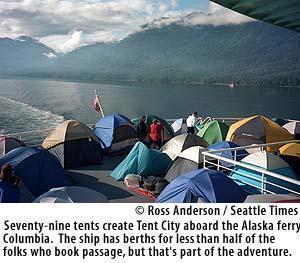 
Copyright © 1997 The Seattle Times Company
Tuesday, July 1, 1997
Alaska ferry Columbia carries a sense of adventure
by Ross Anderson
Seattle Times staff reporter

ABOARD THE FERRY COLUMBIA IN THE GEORGIA STRAIT - Barely 10 days ago, Chris Syrjala woke her four children and said: "Pack your things, gang, cause we're going to Alaska!"
"When?"
"Today! Let's get going."
Eight hours later, Syrjala and her teenaged brood were camped comfortably in a lightweight tent next to mine, lashed to the stern of the Alaska ferry Columbia, and headed up North.
Nary a complaint was heard from the Syrjala clan.
"It's crazy, I know," Mom admits. "But I've always wanted to make this trip. I called the ferry Friday morning, and they had room for us on deck. I thought about it: The kids were all out of school - uncommitted - and three of them go for half-fare.
"If not now, then when?"
So it goes for most of the 643 souls (plus 66 crew members) aboard the Columbia, which tossed off its lines on a Friday evening and headed north.
We are a motley band of adventurers. Take, for example, Tom and Carolyn Ganner, geologists and seasoned travelers from Death Valley, Calif. A few weeks ago, they drove north to Bellingham and climbed onto the Alaska ferry, determined to hike the Chilkoot Pass.
Or Jim and Gloria McCarthy, from Tulare, Calif., who are on a two-week package tour of Alaska to celebrate their 50th wedding anniversary. Or the retired timber executive from Seattle and his wife en route to Skagway to visit their son.
There is 19-year-old Matt, with a scraggly moustache and rings through his lower lip, who plans to get a job in a fish cannery in Ketchikan.
His pal, Skip, has set his sights higher. He plans on making big bucks in the Prudhoe Bay oil fields. He hasn't yet figured out that when he reaches the end of this voyage, he's still not halfway to Prudhoe Bay.
Then there's your reporter, a vagabond journalist just setting out to retrace the trail of the Klondike Gold Rush, the frenzied event that put Seattle on the map.
And my historical traveling companion, Mont Hawthorne, with his shaggy dog, Pedro. Both made this trip nearly 100 years ago, and their spirit now inhabits this ship.
With just 91 cabins, the Columbia has berths for fewer than half of us. But this doesn't matter.
Passengers have made camp in the lounges and on the stern decks, where I count 79 tents of various sizes, colors and shapes. Tent City, as it is called, quickly becomes a successful experiment in close living and human collaboration.
Those on the edge lash their tents to the rails. Others duct tape their tents to the deck and lash them together. The winds and slipstream cause the lightweight domes to shudder and bend like amoeba, but nobody is blown away.
People share food, trade stories, watch each other's kids and alert each other to sightings of whales, bald eagles, genuine Alaskans or other wildlife.
Under other circumstances, these conditions might lead to hard feelings. But not here. The Columbia is fueled by a sense of adventure.
"It wasn't much different a century ago," says Mont, my friend and guide.
"There ain't nothin' like heading up North to make folks feel their oats," he says, shaking his head and stroking his footlong beard as he examines Tent City.
One hundred years ago, Mont set out from Astoria aboard the round-bottomed steamer, George W. Elder, bound for Skagway and the Klondike gold fields via this same route.
Unlike our voyage, the Elder encountered foul winter storms through the Inside Passage, the ship rocking and rolling until "everyone was sicker 'n dogs," Mont recalls.
"No, that ain't right, 'cause Pedro and the rest of them dogs was even worse off. . . .
"But sick as I was, and foolish as it might seem to give up a good job to go prospecting, I was glad, REAL GLAD, that I was headin' up North."
By that time, after the arrival in Seattle on July 17, 1897, of the steamer, Portland, and its cargo of gold and newly-rich prospectors, the stampede was well under way.
In the five weeks following the Portland's arrival, at least 20 steamers left Seattle and other West Coast ports, bound for Alaska and the Yukon River.
The small Seattle steamer, Alki, was the first to get under way, horribly overloaded with 110 passengers, 900 sheep, 65 head of cattle, 30 horses and 350 tons of supplies.
Even Seattle Mayor W.C. Wood was afflicted with Klondike fever.
He submitted his resignation, raised $150,000 from various investors, bought an ocean steamer, and began selling tickets and cargo space.
Every northbound ship was similarly, and dangerously, overloaded.
"Didn't matter one bit," says Mont. "Folks was feeling their oats. They figgered their luck was good, or they wouldn't be starting out in the first place. So no matter what happens to them, they go around talkin' and braggin' and hopin'."
He eases back in his lounge chair, watching the forested slopes and snow-capped peaks drift past the window.
"We felt good. That is, at first we did. We didn't know what was ahead of us. We was headed north, and that's all we cared."
Reality made a rude appearance the next day, as the George W. Elder steamed toward Juneau.
"We got word that a ship had blowed up between Juneau and Skagway," Mont recalled, still gazing out that window. "We was supposed to keep going past Juneau, find that ship and look for survivors."
They pressed on to where the steamer, Clara Nevada, had been reported.
"We gathered in little groups along the rail, while the boat jig-jagged back and forth. We come to a place where the water was covered with boards and stuff. . . . But there wasn't a soul left.
"Seemed like, just standing there and looking at those little boards that had been that big ship, and then looking up at them high mountains, and knowin' we had to go over them, and then on beyond. . . . Well, it quieted us down. . . .
"Somehow, we didn't feel the same way anymore. This country didn't look so cordial. It made you feel like cutting out the horseplay and saying a prayer for those fellows who wasn't here no more. And maybe for the rest of us who didn't know what was ahead of us, either."

Alaska Marine Highway site
|



